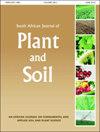Response of soil carbon fractions in a Haplic Cambisol to crop rotation systems and residue management practices under no tillage in the Eastern Cape, South Africa
IF 1.1
Q3 AGRONOMY
引用次数: 1
Abstract
Soil organic carbon (SOC) is a major indicator of soil quality and/or health but its slow short-term response to management changes has prompted the search for more sensitive indicators for monitoring short-term changes in soil organic matter (SOM). This study aimed to investigate the short-term effects of crop rotation systems and residue management practices under no tillage on selected soil carbon fractions of a Haplic Cambisol, using plots from a conservation agriculture (CA) field trial (split plot design replicated in three blocks). The main plots were comprised of the crop rotation systems: maize-fallow-maize (MFM), maize-fallow-soybean (MFS), maize-wheat-maize (MWM) and maize-wheat-soybean (MWS). Residue management practices that included residue removal (R−) and residue retention (R+) were allocated to the sub-plots. The carbon fractions measured were SOC, microbial biomass carbon (MBC), mineralisable carbon (Cmin) and particulate organic matter carbon fractions (POM-C). Crop rotation systems significantly (p < 0.05) influenced Cmin and POM-C fractions whereas residue management practices significantly (p < 0.05) affected all the carbon fractions. Crop residue retention as opposed to its removal enhanced all the carbon pools. The POM-C and Cmin fractions were more sensitive to short-term CA management interventions than SOC and MBC, therefore they can be used for monitoring SOM changes and microbial activities.南非东开普省Haplic Cambisol土壤碳组分对免耕轮作制度和秸秆管理措施的响应
土壤有机碳(SOC)是土壤质量和/或健康的主要指标,但其对管理变化的短期反应缓慢,促使人们寻找更敏感的指标来监测土壤有机质(SOM)的短期变化。本研究旨在探讨免耕条件下轮作制度和秸秆管理措施对Haplic Cambisol土壤碳组分的短期影响,研究采用保护性农业(CA)田间试验的地块(分成三个地块重复设计)。主要地块采用玉米-休闲-玉米(MFM)、玉米-休闲-大豆(MFS)、玉米-小麦-玉米(MWM)和玉米-小麦-大豆(MWS)轮作系统。将残留去除(R−)和残留保留(R+)的残留物管理措施分配到子样地。测定的碳组分包括有机碳(SOC)、微生物生物量碳(MBC)、可矿化碳(Cmin)和颗粒有机质碳(POM-C)。轮作制度显著(p < 0.05)影响Cmin和POM-C组分,而秸秆管理制度显著(p < 0.05)影响所有碳组分。作物残茬的保留,而不是去除,增强了所有的碳库。与SOC和MBC相比,POM-C和Cmin组分对短期CA管理干预更为敏感,因此它们可用于监测SOM变化和微生物活动。
本文章由计算机程序翻译,如有差异,请以英文原文为准。
求助全文
约1分钟内获得全文
求助全文
来源期刊

South African Journal of Plant and Soil
Agricultural and Biological Sciences-Plant Science
CiteScore
1.90
自引率
11.10%
发文量
32
期刊介绍:
The Journal has a proud history of publishing quality papers in the fields of applied plant and soil sciences and has, since its inception, recorded a vast body of scientific information with particular reference to South Africa.
 求助内容:
求助内容: 应助结果提醒方式:
应助结果提醒方式:


